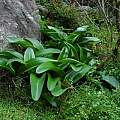Haemanthus species a-c are found on this wiki page.
Haemanthus d-l - Haemanthus m-z
Haemanthus albiflos Jacq. see the Haemanthus albiflos page.
Representative photos of this species from Byron Amerson, Andrew Harvie, Cameron McMaster, Mary Sue Ittner, and Nhu Nguyen.
Haemanthus amarylloides Jacq. see the Haemanthus amarylloides page.
Representative photos of this species from Alan Horstmann, Uluwehi Knecht, Nhu Nguyen, and Michael Mace.
Haemanthus barkerae Snijman is found in the plateau between the Bokkeveld mountains near Nieuwoudtville, South Africa. It flowers in March-April (late summer - early fall). Flowers are pinkish with yellow stamens. The plant has 2 leaves with spotting at the bases. This is a clumping species, growing to about 20 cm high. Dylan Hannon noted that this species "stays small (6-8 plants grow comfortably though cramped in a 6" (15 cm) pot)". It takes 5-6 years to flower from seeds. The first photo below shows first year seedlings grown by Nhu Nguyen. The second and third photos from Mary Sue Ittner show a first flowering in northern California August 2009 from a bulb grown from seed. The fourth through sixth photos show how the bud emerges. In the fourth photo, taken in early morning, the bracts are just starting to emerge and are translucent white. In the fifth photo, taken in the late afternoon of the same day, the bracts have turned light pink and the florets are starting to emerge. In the sixth photo, taken a day and a half later, the florets are opening. From a distance, the flower looks like a bright pink autumn crocus. Photos 4-6 by Michael Mace.
The following photos show H. barkerae in seed. The first photo shows the infructescence. Fertilized fruit range in size from peas to small grapes, and are the color of pink cotton candy (the twist ties mark unsuccessful hybrid crosses with Nerine and Amaryllis that were attempted by the grower). When the fruits mature, they drop to the ground. As shown in the second photo, the fruits are opaque and firm when they first drop off the plant, but rapidly liquefy. The fruit on the right is breaking down. The third photo shows the fruit cut open to display the seed inside, which is glossy and dark reddish brown. Photos by Michael Mace.
The leaves are patterned with spots as shown in this photo by Ken Blackford. The plant has split since originally purchased as a seedling from Dylan Hannon. The leaves grew slightly etiolated having grown on a shelf in part shade with only a couple hours of direct sun each day in the short days of winter. Its blooms are slightly larger than those shown above. (The unspotted plant to the right is a Lachenalia volunteer.)
Haemanthus canaliculatus Levyns is found on swampy coastal flats in a very narrow area of the southwest Cape. It has succulent channeled leaves that appear after the inflorescence and have red barring near the base. Leaves are present from May until December and flowering occurs February to March. It has bright red or occasionally pink flowers and resembles Haemanthus sanguineus but has a spreading umbel with 5-7 narrow spathe valves. Height: to 20 cm. In nature it only flowers after a fire, but since it flowers in cultivation it is speculated that the clearing of vegetation, not the fire itself, is what stimulates it to bloom. An article here describes the plant's rapid response to a fire. Photos were taken by Cameron McMaster near Betty’s Bay in the Overberg. The third picture shows a leaf even though they are not usually present at flowering.
Haemanthus carneus Ker Gawl. see the Haemanthus carneus page.
Representative photos of this species from Nhu Nguyen, Byron Amerson, Mary Sue Ittner, and Cameron McMaster.
Haemanthus coccineus L. see the Haemanthus coccineus page.
Representative photos of this species from Mary Sue Ittner, Nhu Nguyen, Lynn Edwards, Alan Horstmann, and Pontus Wallstén.
Haemanthus crispus Snijman is found from the Western Cape to Namaqualand. This is one of the smaller Haemanthus with the peduncle 5 to 6 in (up to 15 cm) long. It usually has two leaves that are suberect to recurved, strap-shaped, and channeled with undulate edges. Leaves of immature bulbs lack the undulation. Flowers are in a dark red or pink scape, red or sometimes pink. This species flowers from March to April (before leaves) in habitat in the Southern Hemisphere, usually earlier in cultivation. The first two photos by Alessandro Marinello and the next from Mary Sue Ittner taken in Namaqualand.
Photos below from Alan Horstmann showing a flower, leaves, and fruit in habitat.
Haemanthus index - Haemanthus d-l - Haemanthus m-z











































